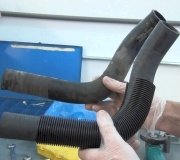Hello,
Thank you for the information. just a couple of things and then I have attached some tests for you to perform.
Are you sure that the radiator fan is the one spinning and not the condenser? I have attached the picture showing the difference.

Also, check the motor of both fans for operation by unplugging them and connecting the battery directly to each one. if the spin then the motors a most likely good.
Does the heater work okay inside the car?
When was the last time you changed your thermostat? If it has been some time I would change it and get a new radiator cap.
Next, if it is driveable, please go to Auto Zone (AZ) or O'Reilly's (or) and for free they can pull the codes to the car. Most important: Once they check your codes, if they find something and you do not get it fixed and need to get back with us, please make sure you tell us exactly what the code was, number and all. Example, if the code was E0568 O2 Sensor bad. Then make sure you give us all of that. While there for free also they can bring their tester out and check your battery and alternator.
Okay, please perform the checks below:
For this test I believe you can go to an Auto Zone and they have this tester you can check out under the tool program.
Cooling system pressure testing.
Notes :
Wait until the engine is cool, then carefully remove the radiator cap and fill the radiator with engine coolant to the top of the filler neck.
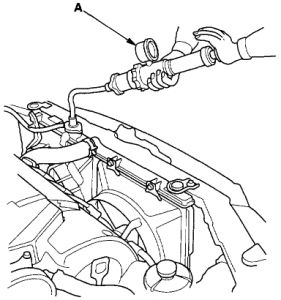
Attach the pressure tester (A) (commercially available) to the radiator and apply a pressure of93-123 kPa (0.95-1.25 kgf/cm2, 14-18 psi) .
Inspect for engine coolant leaks and a drop in pressure.
Remove the tester and reinstall the radiator cap.
Check for engine oil in the coolant and/or coolant in the engine oil.
Next Check
Radiator Fan Circuit
Notes
Check the No.57 (20 A) fuse in the under-hood fuse/relay box. Is the fuse OK? YES -Go to step 2. NO -Replace the fuse and recheck.
Remove the radiator fan relay from the under-hood fuse/relay box, and test it. Is the relay OK? YES -Go to step 3. NO -Replace the radiator fan relay.
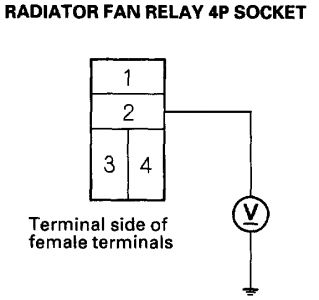
Measure the voltage between the No.2 terminal of the radiator fan relay 4P socket and body ground. Is there battery voltage? YES -Go to step 4. NO -Replace the under-hood fuse/relay box.
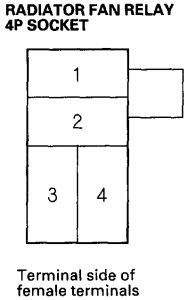
Connect the No.1 and No.2 terminals of the radiator fan relay 4P socket with a jumper wire. Does the radiator fan run? YES -Go to step 9. NO -Go to step 5.
Disconnect the jumper wire.
Disconnect the radiator fan connector.
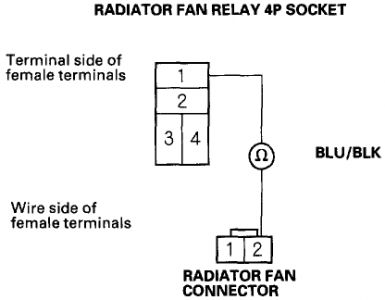
Check for continuity between the No.1 terminal of the radiator fan relay 4P socket and the No.2 terminal of the radiator fan connector. Is there continuity? YES -Go to step 8. NO -Repair open in the BLU/BLK wire between the under-hood fuse/relay box and the radiator fan.
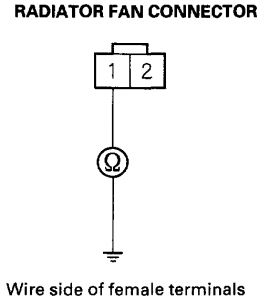
Check for continuity between the No.1 terminal of the radiator fan connector and body ground. Is there continuity? YES -Replace the radiator fan motor. NO -Check for an open in the BLK wire between the radiator fan connector and body ground. If the wire is OK, check for a poor ground at G201.
Disconnect the jumper wire, and turn the ignition switch on (II).
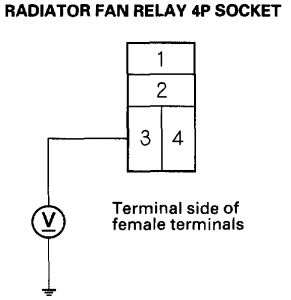
Measure the voltage between No.3 terminal of the radiator fan relay 4P socket and body ground. Is there battery voltage? YES -Replace the under-hood fuse/relay box. NO -Go to step 11.
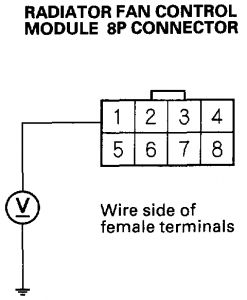
Measure the voltage between the No.1 terminal of the radiator fan control module and body ground. Is there battery voltage? YES -Repair open in the YEL wire between the under-hood fuse/relay box and the radiator fan control modules NO -Perform the radiator fan control module input tests. Refer to Cooling Fan Control Module / Testing and Inspection.
Next Test
Radiator Fan Switch Circuit
Notes
Disconnect the radiator fan switch A connector.
Turn the ignition switch ON (II).
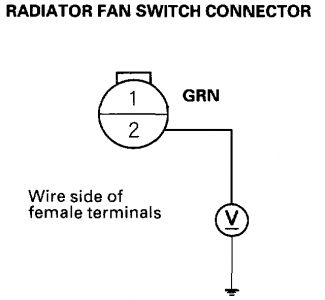
Measure the voltage between the No.2 terminal on the radiator fan switch connector and body ground. Is there battery voltage? YES -Go to step 4. NO -Repair open in the GRN wire between the radiator fan switch A and under-hood fuse/relay box.
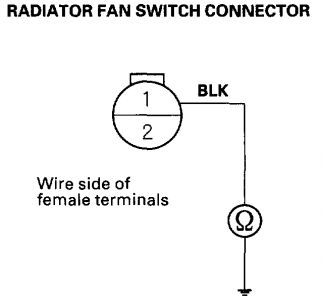
Turn the ignition switch OFF, and check for continuity between the No.1 terminal on the radiator fan switch A connector and body ground. Is there continuity? YES -Go to step 5. NO -Check for an open in the BLK wire between the radiator fan switch A connector and body ground. If the wire is OK, check for poor ground at G101.
Check the cooling system. Is the cooling system OK ? YES -Replace the radiator fan switch A. NO -Repair the cooling system.
Location of Relays
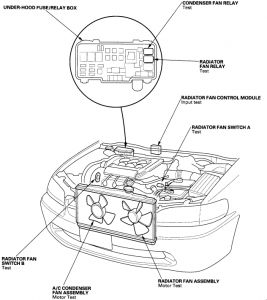
Friday, January 2nd, 2009 AT 7:06 PM












